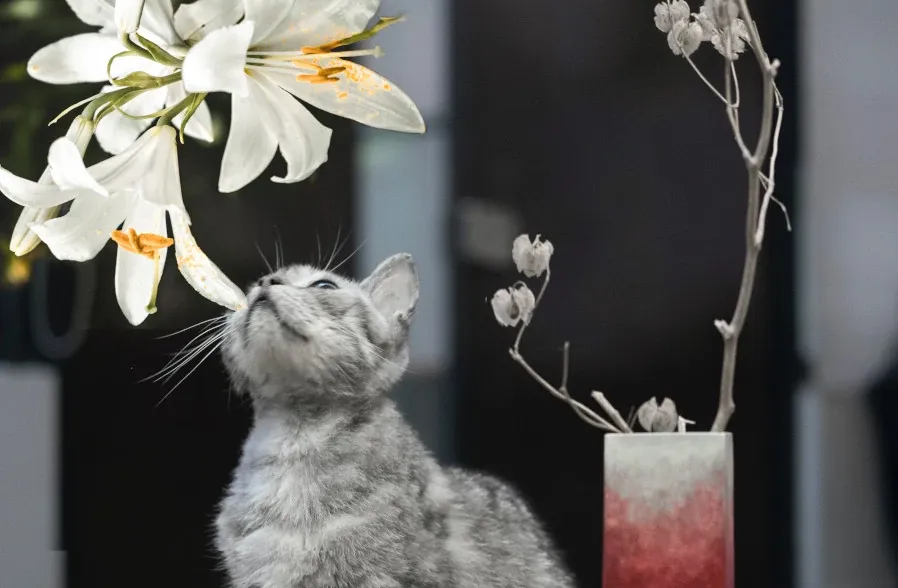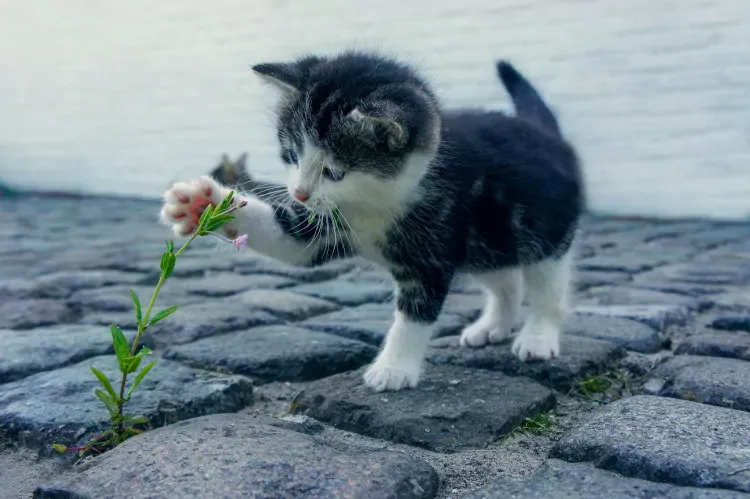Why do Cats Chew on Poisonous Plants?
Cats love plants. Luscious gardens make the perfect hiding spot. Bored indoor cats constantly search around the home for interesting things to play with - plants included. Cats are drawn to plants and there are some surprising reasons why they will chew on even the deadliest of plants.

Cats are intensely curious and will investigate everything in their environment. This includes taste testing and chewing on anything interesting around the home.
But munching on the wrong plant has landed many cats in serious trouble. One would think that their instinct will protect them, but seemingly, it seldom does.
...nature lovers
Cats love being around plants in the garden and the home. And plants are pretty fascinating things. They move in the breeze, they're vibrantly colourful and they smell interesting.
Garden plants offer a screen from the sun and a cool place to rest. Even a house plant can be the perfect place to rest their weary bones. And dangling cut flowers just beg to be swatted or chomped.
...innate attraction
Cat carers have probably all seen cats munching on a blade of grass. Even lion, tiger and leopard in the wild will frequently eat a bite of grass 1, 2.
Strangely, felines lack the enzymes to break down plant matter, yet they all munch on selected greens. They seem hard wired to this behaviour, which means that greenery probably serves some purpose.
For more on this interesting phenomenon, a separate post excavates interspecies grass eating in cats.
...an education gap
The problem is this. Cubs and kittens in the wild are taught which plants are safe to ingest. But domestic kittens are mostly taken away from queens before they learn about their instinctual diet and eating behaviours.
We instead imprint on them to eat commercial food. Cats grow up quite misguided about what is food and what is not.
So, they have this instinctual drive to ingest some greenery, but lack the knowledge to safely do so.
...no perceptible warnings
The keen noses of house cats seem untrained to identify toxic plant compounds. They appear to be oblivious to the tremendous danger plants sometimes pose.
Our gardens and homes introduce all kinds of exotic, poisonous plants that our cats have no knowledge about.
One thing is for sure, cats in the wild don't mess around with plants they don't know. Small wildcat species most certainly won't risk getting poisoned by chomping on random plants. No, they have a healthy respect for them.
...small wildcat seek out very specific plants
Small wildcat are very meticulous about their plant choices. Southern African wildcat – the closest progenitor of the common house cat – are regularly observed to eat particular plants.
They seem to mostly stick to Eragrostis sp. – a wild grass – and bits of leaves from the bitter, tart Radyera urens plant 3. During field research, material from these plants were frequently found in their scats.
To be exact, 42.3% of the scats analysed had plant matter in them. This supports the thinking that they instinctively seek out greenery and that it serves a purpose.

...the taste test
Cats on commercial foods are taught to eat a wide array of feline inappropriate foods. Plant ingredients make up the bulk of their food, such as grains, vegetables and sometimes fruit.
Despite being carnivores, cats come to accept these plants as food. They go after all kinds of species inappropriate things – including the peas and carrots on your dinner plate.
But plants do not form a significant part of the cat’s instinctual diet. House cats also lack programmed, innate knowledge about them. They know just enough about plants to land them in hot water.
They know that some can be eaten and that they are quite tasty. This could encourage them to taste test plants around the home. Others simply chew on plants out of boredom.
Often times they express instinctual behaviour – but choose the wrong plant.
...plant poisonings are rampant
Effects from plant poisoning can range from mild symptoms to seizures, kidney damage, liver damage and even death 4.
Since its inception, the US Animal Poison Control Center (APCC) has handled more than 4 million poison related calls. In 2018 alone, 11 000 calls were logged.
But their call volume dramatically increased during lock-down. During this time they received an additional 7,500 calls – all about toxic plants 5.
...toxic plants are everywhere
The list of plants that are toxic to cats, is a long one. By comparison, the list of cat safe plants is modest. And internet sources often give contradicting and confusing information about their safety.
Plus, plant identification is no easy task. To keep cats safe, it is probably best to treat all plants as potentially toxic, unless there is clear information to the contrary.
It is best to stick to plants that are proven to be safe. This may require some homework. And perhaps keep cats away from all other plants as a rule.
There are more than 380 000 known plant species 6, the majority of which have not been researched for pet safety. Plus, some plants are safe for humans and dogs, but potentially fatal to cats.
Take lilies. Not all lilies are toxic to dogs, but, of all plants, lilies are probably the greatest threat to cats 7.

...lilies are especially bad
When it comes to lilies, every single part of the flower and the plant is dangerous if ingested by cats, including their bulbs 7.
Even just brushing against a lily and depositing pollen on a cat's fur, and them ingesting it while grooming, can trigger acute, fatal kidney failure 8.
A cat might one day decide that it would be interesting to drink from a flower vase. According to some sources, the water in which lilies are stored can also be contaminated with poison 7.
All true lilies are exceptionally dangerous to cats – even those that grow on water ponds 7. Special care needs to be taken with these plants, but it is probably best to not have them around cats at all.
...other dangerous plants
Apart from lilies, there are many other toxic plants to be aware of. Tulips, Azaleas, Narcissus (including Daffodils), Oleander, Dieffenbachia (house plants) and Philodendrons can also cause critical illness 7, 9.
Sago Palms (Cycas revoluta), Autumn Crocus, Hyacinth, Cyclamen, Rhododendrons and Kalanchoe are also rated as highly toxic 7.
Apart from these plants, there are hundreds more that are toxic to cats. Be.chewy.com offers a great resource to this effect. They discuss the 12 most common poisonous plants for cats, but list hundreds more.
The most comprehensive is probably the ASPCA's list of poisonous plants to cats (https://www.aspca.org/pet-care/animal-poison-control/cats-plant-list accessed April 5, 2023).
This list is really wonderful as it also lists an assortment of plants that are safe for cats to forage on!
Finally, it is best to do some digging before bringing any plant or flower into the cat's environment – both the home and around the garden. Be safe, and when in doubt, research, research, research.
...what's next?
A lot of the information provided by the Best Fed Cats blog posts centres on research and scientific study results. The next post tackles the question of whether we can still trust the sciences and research results. It also considers what to look at when deciding whether to accept such study results or not.


References
1 Wildlife Trip (2021). What do leopards eat? Discover the leopard diet. Retrieved March 27, 2023, from https://wildlifetrip.org/what-do-leopards-eat/
2 Wild Explained (n.d.). Do lions eat grass? [Yes! Here’s why]. Retrieved March 27, 2023, from https://wildexplained.com/do-lions-eat-grass/
3 Herbst, M. & Mills, M.G.L. (2010). The feeding habits of the Southern African wildcat, a facultative trophic specialist, in the southern Kalahari (Kgalagadi Transfrontier Park, South Africa/Botswana). Journal of Zoology, 280, 403 – 413.
4 Chewy Editorial (2022). 12 Most common poisonous plants for cats. In Be Chewy. Retrieved March 27, 2023, from https://be.chewy.com/which-plants-are-poisonous-to-cats-a-complete-guide/
5 ASPCA (2022). ASPCA Animal Poison Control Center reaches 4 million cases of pet toxicity, a significant milestone in keeping animals safe in emergency situations. Retrieved March 28, 2023, from https://www.aspca.org/about-us/press-releases/aspca-animal-poison-control-center-reaches-4-million-cases-pet-toxicity
6 Plant (n.d.). In Wikipedia. Retrieved March 28, 2023, from https://en.wikipedia. org/wiki/Plant
7 Town & Country Veterinary Clinic (n.d.) Why are lilies poisonous to cats? A guide to poisonous plants. Retrieved March 27, 2023, from https://tcvcmarinette.com/cat-lily-poisoning/
8 Hofve, J. (n.d.). Lilies that kill. In Little Big Cat. Retrieved March 27, 2023, from https://littlebigcat.com/lilies-that-kill/
9 Lee, J.A. (n.d.). Why do cats eat plants, and should I be worried? In Pet Health Network. Retrieved March 27, 2023, from https://www.pethealthnetwork.com/cat-health/cat-toxins-poisons/why-do-cats-eat-plants-and-should-i-be-worried
Disclaimer
The information provided on the Bestfedcats.com website is educational and informational. We are here to give guidance on how to feed a properly balanced raw diet. We also offer advice on how to improve the diet of the modern house cat. Please note that we are not veterinarians. We are not here to give veterinary advice. Best Fed Cats will not be held responsible for any adverse reactions to your cat based on the information on our website. The health of your cat depends entirely on you. We expect you to use your knowledge of your cats, their circumstances and their health – in conjunction with a trusted veterinarian – to determine if any advice provided on this site is appropriate for your cats.

